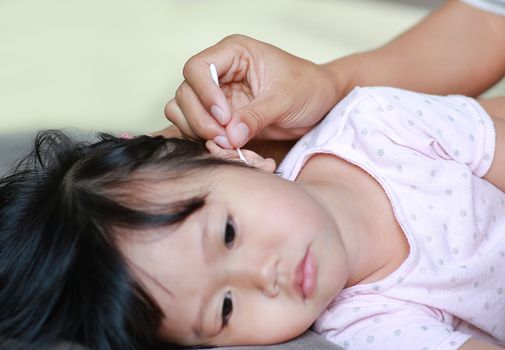Do fathers treat daughters and sons differently? A study published in the journal Behavioral Neuroscience suggests that fathers’ brain responses differ based on the gender of their kids. They were more attentive to their daughters than sons.
The researchers monitored the interaction between 52 fathers and their toddlers (30 girls and 22 boys) with the help of an electronic recorder that was clipped on to the belts of the fathers for 48 hours.
“When a child cried out or asked for Dad, fathers of daughters responded to that more than fathers of sons did,” said the lead researcher. “We should be aware of how unconscious notions of gender can play into the way we treat even very young children.”
Fathers were more attentive to their daughters and also sang to them more often. They responded quickly when their daughters were sad or anxious. But fathers were less attentive to their sons’ feelings and engaged in more rough-and-tumble play with them.
They used words such as “best”, “win”, “super” and “top"—language related to power and achievement—when talking to sons, but used words such as “all”, “below” and “much”—analytical language linked to future academic success—with their daughters.
Additionally, fathers underwent functional MRI brain scans while viewing photos of an unknown adult, an unknown child and their own child with happy, sad or neutral facial expressions. Fathers had greater responses in the areas of the brain important for processing emotions, reward and value when they saw their daughters’ happy faces than their sons’. In contrast, dads’ brains responded more strongly to their sons’ neutral facial expressions.
“The fact that fathers may actually be less attentive to the emotional needs of boys, perhaps despite their best intentions, is important to recognise. Validating emotions is good for everyone—not just daughters,” said the researcher.
Booze beats

Binge drinking can increase the odds of irregular heart rhythms called cardiac arrhythmias in otherwise healthy people.
Arrhythmias can sometimes lead to atrial fibrillation or irregular heart beat that can potentially lead to more serious consequences such as heart failure and stroke.
For the study published in the European Heart Journal, researchers went to the 2015 Munich Octoberfest, the world’s largest beer festival that attracts millions of people. The researchers used a breathalyser to record the breath alcohol concentrations of 3,028 volunteers. Using a portable electrocardiogram (ECG), they also monitored the heart activity of the participants.
The prevalence of arrhythmias in the general population is estimated at between 1 and 4 per cent. But 30.5 per cent of the participants had cardiac arrhythmias. Of them, 25.9 per cent had sinus tachycardia, a condition in which the heart beats at a higher-than-normal rate.
The risk of arrhythmias increased in proportion to the breath alcohol levels. "For each one gram of alcohol per kilogram of blood above zero, the likelihood of a cardiac arrhythmia increased by 75 per cent."
The finding that chronic alcohol consumption is associated with cardiac arrhythmias was also confirmed in another group of 4,131 people.
Cut calories, stay young
Cutting your calorie intake can help you stay young.
Calorie restriction is already known to slow ageing in worms, flies and mice. The current study, published in the Journals of Gerontology, Series A: Biological Sciences and Medical Sciences, sought to find out if it had the same effect in humans.
The study compared 145 people who were randomised to restrict calorie intake by 25 per cent and 75 people who continued with their regular diet. At the start of the study, the participants’ biological age was 37 and their chronological age was 38.
Biological age was calculated based on the function of their cardiovascular, metabolic and immune systems. The biological age of the calorie restriction group increased an average of 0.11 years at each 12-month follow-up, whereas the biological age increased by 0.71 years in the normal diet group. "Our findings suggest a template for developing and evaluating therapies designed to mimic the effects of caloric restriction to ultimately prevent chronic diseases."
Leave ears alone
Using cotton swabs to remove wax from your children’s ears can be dangerous.

According to a study published in the Journal of Pediatrics, about three dozen children in the United States are treated in hospital emergency departments daily for cotton-tip applicator-related ear injuries.About 40 per cent of these injuries occur in children under age 3.
The most common injuries are foreign body sensation, perforated ear drum and soft tissue injury.
While most patients do not require hospitalisation, damage to the ear drum, hearing bones or inner ear can result in dizziness, balance problems and irreversible hearing loss.
“The two biggest misconceptions I hear as an otolaryngologist are that the ear canals need to be cleaned in the home setting, and that cotton tip applicators should be used to clean them; both of those are incorrect. The ear canals are usually self-cleaning. Using cotton tip applicators to clean the ear canal not only pushes wax closer to the ear drum, but there is a significant risk of causing minor to severe injury to the ear," the senior study author noted.
Therapy for PE
Premature ejaculation is the most common male sexual dysfunction, affecting about 1 in 3 men between the ages of 18 to 59. But there are only limited options available to them.
A new study presented at a meeting of the American Urological Association has shown that topical 4 per cent benzocaine wipes may help men address this problem.
For the study, 15 of 21 heterosexual men in monogamous relationships with premature ejaculation received benzocaine wipes, while 6 received a placebo. After two months, men who received benzocaine wipes saw significant improvement in the physical and psychological symptoms of premature ejaculation. They also reported greater improvement in distress relating to intercourse, control of ejaculation, satisfaction with sexual intercourse, more pleasure and reduced frustration.
Did You Know
Stage 3 colon cancer patients who ate at least 2 ounces or more of nuts per week had a 42 per cent lower chance of cancer recurrence and a 57 per cent lower risk of dying from the disease compared to patients who did not eat nuts after completion of their cancer treatment.
Findings presented at the 2017 American Society of Clinical Oncology Meeting
Against surgery
Knee arthroscopy (keyhole surgery) is commonly performed in patients with arthritis or degenerative knee problems. But an international panel of experts is strongly recommending against the procedure for nearly all cases of degenerative knee disease, including osteoarthritis and tears of the meniscus—damage to the rubbery discs that cushion the knee joint.

Knee arthroscopy is one of the most common orthopaedic procedures. About two million people worldwide undergo knee arthroscopy every year.
The guidelines, published in the BMJ, reviewed 13 studies which found that surgery does not provide lasting pain relief or improvement in function. It offers little benefit for most patients and is not cost effective.
Less than 15 per cent of the patients saw slight improvement in pain and function three months after the surgery. But the benefits did not last beyond a year. Among patients with a degenerative medial meniscus tear, knee arthroscopy was no better than exercise therapy.
Additionally, surgery can expose patients to "rare but important harms".
Did You Know
Just two weeks of physical inactivity can cause healthy, young people to lose muscle mass, to accumulate body fat and produce metabolic changes that can increase their risk of developing chronic conditions such as type 2 diabetes and heart disease which can potentially lead to premature death.
Findings presented at the European Congress on Obesity
BP during pregnancy
Pregnant women should be screened for preeclampsia throughout their pregnancy, according to recommendations from the US Preventive Services Task Force published in the Journal of the American Medical Association. Doctors should check their blood pressure at every prenatal visit even if they have no symptoms of preeclampsia.

Preeclampsia is a pregnancy complication characterised by high blood pressure. It usually begins after 20 weeks of pregnancy and can lead to serious, even fatal complications for both the mother and her baby. It is the second leading cause of maternal mortality worldwide and may lead to serious complications, including stroke, seizures and organ failure. It is harmful to the baby, too, resulting in low birth weight, preterm birth or even death.
Preeclampsia could also cause the placenta to detach from the uterus.
The only treatment for preeclampsia is delivery, often before the baby's due date.
“Obtaining blood pressure measurements to screen for preeclampsia could allow for early identification and diagnosis of the condition, resulting in close surveillance and effective treatment to prevent serious complications.”
Modified to fight superbugs
Scientists in the US may have found a way to combat the looming threat of antibiotic resistant bacteria, or superbugs. The researchers structurally modified the lifesaving antibiotic vancomycin to make it much more potent.
Vancomycin has been prescribed by doctors for 60 years, and bacteria are only now developing resistance to it, suggesting that it might be difficult to overcome the drug's mechanism of action, which works by disrupting how bacteria form cell walls. The lead researchers called vancomycin "magical" for its proven strength to fight infections.
The research team had previously made two modifications to the antibiotic to make it even more potent. Now they have added a third, which gives vancomycin a 1,000-fold increase in activity. "With these modifications, you need less of the drug to have the same effect," the lead researcher noted.
Vancomycin now will have three independent mechanisms of action. "This increases the durability of this antibiotic. Organisms just can't simultaneously work to find a way around three independent mechanisms of action. Even if they found a solution to one of those, the organisms would still be killed by the other two."
In lab tests, this version of vancomycin killed both vancomycin-resistant Enterococci and the original forms of Enterococci. "Doctors could use this modified form of vancomycin without fear of resistance emerging." The findings were published in the journal Proceedings of the National Academy of Sciences.
Did You Know
Children under two years who spent more time on hand-held devices such as smart phones and tablets may be at risk for speech delays. For every 30-minute increase in handheld screen time, there was a 49 per cent increased risk of expressive speech delay.
Study presented at the Pediatric Academic Societies Meeting
Drug warning
The type 2 diabetes drug canagliflozin can increase the risk of leg and foot amputations, the US Food and Drug Administration warns.

The new warning is based on findings from two clinical trials that showed that leg and foot amputations occurred about twice as often in patients treated with canagliflozin than those treated with a placebo. The most common amputations were of the toe and middle of the foot. But amputations of the leg, below and above the knee, also occurred, and some patients had more than one amputation.
Patients taking canagliflozin should notify their doctors immediately if new pain or tenderness, sores or ulcers, or infections in the legs or feet occur. Before starting treatment, doctors should consider factors such as history of prior amputation, peripheral vascular disease, neuropathy and diabetic foot ulcers that can predispose patients to the need for amputations.
Canagliflozin drug labels will now carry a boxed warning to describe the risk.
More benefits
Regular use of low-dose aspirin (81mg) can lower the risk of breast cancer, according to a study published in the journal Breast Cancer Research.

Many adults already take low-dose aspirin to reduce their risk of heart disease.
For the study, 57,164 women answered questions about their family history of cancer, use of aspirin and other nonsteroidal anti-inflammatory drugs, menstrual and reproductive history, use of hormones, weight and height, diet, alcohol use and physical activity in 2005.
By 2013, 1,457 of the participants had developed invasive breast cancer.
Women who took low-dose aspirin at least three times a week were 16 per cent less likely to develop breast cancer. The risk was 20 per cent lower for oestrogen or progesterone receptor positive, HER2 negative breast cancer, the most common breast cancer subtype.
"The study found an interesting protective association between low-dose aspirin and breast cancer," said the lead author.
But no association was seen with regular-dose aspirin or other pain medications like ibuprofen and acetaminophen.
"We already knew that aspirin is a weak aromatase inhibitor and we treat women with breast cancer with stronger aromatase inhibitors since they reduce the amount of oestrogen postmenopausal women have circulating in their blood. We thought that if aspirin can inhibit aromatase, it ought to reduce the likelihood that breast cancer would develop and it could also be an effective way to improve breast cancer patients' prognosis once they no longer take the more potent aromatase inhibitors.
Aspirin also reduces inflammation, which may be another mechanism by which aspirin taken regularly can lower risk of breast cancer developing or recurring," the study author explained.
Choking on lung cancer
Getting a cancer diagnosis is devastating—it can increase the risk of suicide. According to a study presented at the meeting of the American Thoracic Society, of all cancers, people with lung cancer have the greatest risk of committing suicide.

The study analysed data from 36,40,229 patients over a 40-year period. Cancer diagnoses were associated with 6,661 suicides.
The risk of suicide was 60 per cent higher with any cancer compared to the general population. The risk was 40 per cent higher for colorectal cancer and 20 per cent higher for breast and prostate cancers.
But lung cancer had the greatest risk—a whopping 420 per cent greater risk. Among lung cancer patients, suicide risk was higher among Asians, males, widowed patients, older patients, patients whose cancer had spread to other areas of the body and patients who refused surgery.
“It is important to identify these high risk patients in order to provide the proper psychological assessment, support, and counselling to reduce these rates,” the study concluded.
CONTRIBUTOR: SHYLA JOVITHA ABRAHAM






